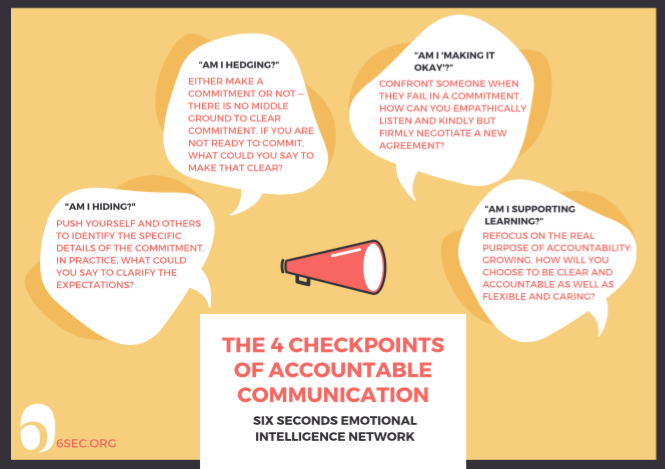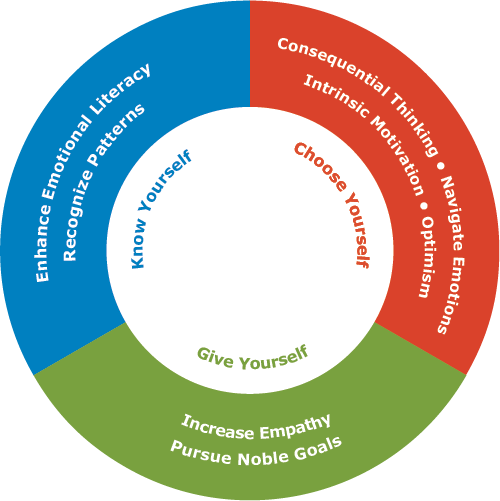Creating a Culture of Accountability: The 4 Checkpoints of Accountable Communication
Make clear commitments without wiggle room and you will empower yourself and others. Download our free poster with practical tips for practicing accountable communication.
By Joshua Freedman

Is it even possible to hold someone accountable? Some people talk about accountability as a system for making sure people do what we want them to do. In other words, a way of creating obedience — the person in power shapes behavior through rewards and punishments. In this system, the “boss” sets expectations, and the “inferior” person complies. The boss “holds people accountable” by punishing those who disobey. While the subordinate may follow through, they really on do it out of fear or greed — without the boss and his rewards or punishments, the action would not occur. So, the “inferior” only does the work when he might get caught — this is obedience, not accountability.
So what’s real accountability? Accountability means accepting responsibility for the outcome of your choices. It means taking ownership of your life — the successes and the failures. Under this definition, I can not make someone else accountable, all I can do is set a context for people to become accountable. If I take responsibility for someone else’s life, I actually take away his accountability.
Are You In the Driver’s Seat?
If accountability means “owning my results” (another way of saying, “accepting responsibility for the outcomes of my choices”) then what’s the opposite? Non-accountability means giving up ownership, or even forcing others to take ownership of my results. It means being a victim. Think of a non-accountable person in a workplace — can you see how they evade responsibility for failures AND for successes? They’re along for the ride. So the question of accountability is simple: Do you want to ride along in your life, or drive?
If I am not choosing to be accountable, what am I choosing? If I “ride along,” am I part of the problem instead of part of the solution? Am I a “slacker?” A “taker?” A “victim?” Sometimes I am all of these. Sometimes I choose to take a break from the hard work of actually leading my life. Ironically I’m most likely to do that at home — in the place I care most about modeling my best self. One reason it’s easy for me to be less accountable at home is that my wife is so strong, capable, and nurturing. I know she’ll forgive me, and I take advantage of that by doing less than my best. It’s awfully seductive sometimes to stay in that passive, non-accountable role.
When I was teaching, it was a constant struggle to increase accountability for some students. Some kids consistently failed to do their best work, and I told them I was not satisfied with that performance. At the same time, I know that sometimes I read student homework thoroughly, and sometimes I barely looked at it. The result was that I was creating a context of inconsistent accountability — not only was I modeling poorly, I was making the choice to leave “wiggle room” or ambiguity. I can see now that if I wanted my students to be more accountable, I had to be more accountable.
In my work with managers, teachers, and parents, I see this dynamic over and over. We want people to behave a certain way, and we confuse obedience and accountability. Real accountability takes a great deal of effort, so we attempt to mandate it, and the results are mediocre. When it’s something people “should do,” those who don’t like accountability dig in their heels and resist — the more it’s a “have to,” the more they resist! On the other hand, if the resistors can see that accountable people have more inner power, learning, joy, and fulfillment, perhaps they’ll be more likely to join?
If we want better results, we become doubly accountable. We find the loopholes and “wiggle room” we’re leaving, and do the hard work to close those gaps. Then we do the even harder work of following through on every single promise that we make. Against that backdrop, others’ lack of accountability becomes vivid and uncomfortable, and they develop an inner motivation to grow.
Why We Block Accountability
Wiggle room is the gray area we leave when we don’t say what we really mean because we are not committed to total clarity. In my own interactions, I leave wiggle room for a variety of reasons. If I take out the wiggle room — and use accountable communication — I have to make stronger commitments. There are some significant costs to getting to that level of clarity.
- Clarity takes time: In the rush of day-to-day life, who has time to slow down and be specific?
- Clarity might mean more work: For example, perhaps Patty, my wife, is asking me to help get ready for a party. I suspect she wants a lot of work from me, so I evade a specific commitment — I don’t say exactly what I will do, by when; instead I work a bit then hide for awhile. In consultant-speak, I have not committed to specific deliverables.
- Clarity can mean loss of face: If I make a specific commitment and don’t follow through, it will be evident that I failed.
- Seeking clarity can imply a lack of trust: When you ask questions about “what exactly am I committing to?” and “What if it doesn’t go as planned?” people begin to call you “lawyer-ish.” They might even say, “It will just work out, don’t you trust me?”
- Asking for specific commitment appears aggressive: Especially for people conditioned to “be nice,” it can be extremely uncomfortable to push someone to make a clear commitment.
- An ambiguous agreement might lead to a “better deal”: If we pin one another down to specifics, there’s no way I am going to get more that I’ve asked for, but if it’s open, I could be pleasantly surprised.
Given all these problems with creating accountability, why would I do it? Just reading my own list I’m feeling threatened by the apparent conflict in this accountable communication! First, it’s important to see that many of those potential negatives are simply assumptions. For all I know, the other person could welcome accountable communication as a breath of fresh air! The certain negatives of non-accountability should have more weight than the potential negatives of my assumptions. More importantly, by practicing accountable communication I will empower myself and empower others.
How To Increase Accountability: The 4 Questions
So, assuming you see that the benefits outweigh the costs, here are four “checkpoints” to watch in creating accountable communication. If you want a free poster with these 4 questions to hang in your office as a reminder, just fill in the form at the bottom of the page.
1. Am I hiding? (Don’t miss the chance!)
2. Am I hedging? (Don’t “try”!)
3. Am I “making it ok“? (Don’t “rescue”!)
4. Am I supporting learning? (Don’t over-simplify!)
1. “Am I hiding?” is a reminder to push yourself and others to identify the specific details of the commitment — often called “rules of engagement,” “deliverables,” or “conditions of satisfaction.” In practice, this might sound like, “I am not 100% clear on what you want me to agree to — let’s talk through the specifics.” Or, “Let me repeat back what I hear you asking.” The words you use are not so important as your intention to be clear. Sometimes people will be rude or tactless in the name of clarity, “I’m just being direct,” they’ll say to themselves. Most often, this kind of behavior is just another way of hiding. Some people hide from clarity through shyness, some people hide through roughness, neither works. True clarity is vivid and calm — like a cool wind on a hot day, like a silver bell ringing in the gloaming, like a child’s kiss on your cheek. When you experience it, you know. If you choose to stop hiding, you will experience clarity more often.
2. “Am I hedging?” asks you to either make a commitment or not — there is not middle ground to clear commitment. If you are not ready to commit, say, “Right now, my answer is no,” or “I will think about it,” or “I’d like to discuss this again in 24 hours.” Most people say, “I’ll try,” when they mean, “No, but I don’t want to let you down,” or “This is a low priority for me.” If you say, “I’ll try,” it leaves wiggle room a mile wide. If you intend to leave wiggle room, then saying, “I’ll try” is effective. You just have to be careful because it’s totally ambiguous; you might mean, “I’m going to commit in a moment,” or you might mean, “Not in a hundred years!” — how are other people going to know? They’ll make assumptions about what you mean by, “try,” you’ll make assumptions about what they heard, and you will have a muddle.
3. “Am I “making it ok”?” If you are “making it ok” when someone fails in their commitment, you are reducing accountability. If that’s what you intend to do, perhaps because you know they’re just learning, or having a difficult time, then “making it ok” is fine. Otherwise, tell them you are not satisfied and you ask for redress. When they give an excuse, you empathically listen and kindly, firmly negotiate a new agreement. This is a foreign language to many people, it seems uncomfortable and “not nice” to confront someone with their failure to follow through. On the other hand, is it “nice,” to let someone break their word to you and then lie about your real feelings about that? Discomfort is not bad! Discomfort and remorse are important teachers, and when you take those away from people because you don’t like “making them uncomfortable,” you take away their learning. At the same time, remember that people don’t learn under threat — so you have to carefully watch how much you push people. The balance is the point of the last checkpoint.
4. “Am I supporting learning?” is an essential reminder about the real purpose of accountability — growing. And forgiveness is an essential nutrient for growth. Every moment, we each have the chance to practice our skills and get better — the goal is to be conscious and intentional, not to be perfect. I make mistakes, you make mistakes, and others do to. Life is complicated, events occur that we could not predict, and caring people shift their priorities to meet the changing landscape. Sometimes you consciously need to leave wiggle room so people can save face, sometimes you conscious break one of the other three rules. The point is to do this intentionally rather than habitually. You can choose to be clear and accountable as well as flexible, generous, and caring! Just keep practicing.
The Bottom Line: Learning
If you support your own learning, and support others to keep learning, you will automatically increase this deep, meaningful inner accountability. Instead of motivating by punishment, motivate by curiosity. Motivate yourself and others by inspiring commitment to something worth learning, worth learning to do with 100% of your capacity and greatness. This kind of accountability will increase joy, commitment, fun, personal power, and it’s infectious! As you practice internal accountability and clear communication, you become an inspiration to others to do the same, and together you create the best possible results.
This article was first published on 6seconds.org in 2003. This model of accountability is inspired by the late Mike Blondell and by Action Technologies. Updated Jan 15, 2011, and October 2019
Download Free Poster: The 4 Checkpoints of Accountable Communication

What’s new in emotional intelligence?
How to Thrive in a BANI World: Insights from the World’s Largest Study of Emotional Intelligence
Emotional intelligence is declining just when we need it most. Drawing from the the world’s largest EQ study, this article explores why and how to reverse the trend—with women leading the way toward emotionally intelligent leadership.
Why True Leaders Must Think Like Trainers: How to Use Emotional Intelligence to Excel in a Leadership Role
Discover how Emotional Intelligence and a trainer’s mindset can transform leadership, fostering growth, autonomy, and long-term success.
The Six Seconds Model of Emotional Intelligence: What It Is and How to Use It (+ PDF)
What is emotional intelligence and how do you practice it? Explore the Six Seconds Model of Emotional Intelligence to improve your life and relationships.
Unlocking Performance 2.0: Why Emotional Intelligence Is the Key to Leading in a BANI World
Are we looking for solutions in the right place? What if the key to success isn’t stricter control and efficiency, but more empathy and trust?
AI Fakes It: Good Leaders Keep It Real
We tested top GenAI models’ emotional intelligence—what we found reveals insights that every leader needs to know and will change the way you lead in an AI-powered world.
Plutchik’s Wheel of Emotions: Feelings Wheel
Grow your emotional literacy with Plutchik’s Wheel of Emotions. Then download the free Practicing Emotional Intelligence eBook to go deeper!







I was reading this article for my coaching certification program (which is superb!) in the midst of all the news coming in about black lives matter and protesters, thinking about equity and inclusion while reading it. Then I was reminded of the importance of the four checkpoints of accountable communication how they apply to the current situation and how I can clarify my choices as an ally to the ones being maltreated unjustly and also as a first-generation immigrant living in the U.S.
As I read the first checkpoint, Am I Hiding? I thought about how I withhold my voice fearing that I don’t know enough, I may make mistakes, and I am more comfortable hiding. Then the second checkpoint, Am I hedging? asks me if I am committed to the social justice or not. There is no in-between. Then how will it look in my busy life as a single parent and a teacher?
The last two checkpoints are particularly important to me; “Am I making it okay? and “Am I supporting learning?”
As I feel overwhelming feelings around the current situation, I value that growing is the real purpose of accountability. How can I remember this as I watch news? When I am appalled by injustice and sicken to the stomach, how can I remember to choose to be clear and accountable as well as flexible and caring?
me try at a workplace my room in room maryann eva & out room stepahanie mayer maybe can be exciting with google chat workspace thanks
This article is eye opening for me, thank you for putting the process of accountability into such clear terms. I have a lot of work to do…
‘Instead of motivating by punishment,motivate by curiosity’!! Loved this Joshua. Loved the concept of wiggle room too!! I I am going to work on this!! Thank you . Now I just cannot wait to see you in person and learn a lot from you at Chandigarh!! 🙂
Thank you Joshua. Personal accountability is a very meaningful characteristic for me but I found new vulnerability around it with the concept of “wiggle room.” What I appreciate about your suggestions is that they clear a path for reducing one’s ego because one learns to become authentic.
Warmly,
Keyuri
Hi Keyuri – I appreciate that. I find that often I leave “wiggle room” because it feels uncomfortable to be clear — so there is an important connection between Knowing Yourself and then Choosing Yourself for accountability! Then, as you say, letting go of ego so it’s not “about me,” which we call Give Yourself. So all three parts of EQ come into play… awareness, intention, and direction.
– J
I’m only new to your blog but I find it so inspiring. I’m trying to promote EQ in kids from a parent’s perspective and I think that accountability is a very big part of communication between parents and kids that often gets left out. I’m sure this is mostly because parents are hard at it already – especially working parents. I guess its easier just to take the easiest road but obviously this is not always the best route to take. Your points are a valuable resource and can be used quite easily (with practice) in a family setting. I hope you don’t mind but I would love to send this out to my community of friends and followers.
Thanks for helping parents practice EQ — and feel free to share the article to your network.
🙂
– Josh
Thanks for this vivid and clear presentation, which I have found very inspiring. I value this principle of accountability in my own life, but it is always a humbling learning process, as I find myself getting trapped by my own fears and lack of speedy state of mind. Your article hit the reset button for me and clarified my view.
Hi Joshua,
Love the connections that you make with accountability and communications.
Love your work and contributions to EI!
Hi Josh, I just applied to join your network on Linked-In and got a direction to your blog – this is amazing stuff, I love it, well done.
I think what you’ve written here is so pertinent, the true test is the courage to do it. I like that courage comes from ‘Couer’ – I believe the Latin meaning ‘from the heart’.
Thanks so much Peter!
Such an important point you make – it take heart – couer and courage – to put insight into action!
🙂
Realy makes me think about my own life. I think I may be the king of “wiggle room” I struggle with giving deffinate answers, even though most of the time I know exactly how I feel and what should be said. I know this is due to the fact that I want to be nice and avoide confrontation. Im begining to see though, that being direct does not mean you have to be mean. I know for my self when someone is direct with me,I accept it better then when I’m unclear with what they want.
Hi Steven,
One of the big challenges is that when people give those “indefinite” answers (usually because they feel something like worried about being clear) then they often feel uncomfortable with the outcome… but they don’t say anything… and it gets worse and worse — then BOOM, the pressure has become overwhelming and they react in a “mean” way. Then, they get feedback: “Don’t be such a jerk!”
They take away this lesson: “Oh, when I speak up, people get hurt and mad and there’s a big fuss, I shouldn’t do that.” However, another, perhaps more valuable conclusion would be: “When I wait ’till I’m really upset, I don’t communicate well, so I better practice speaking up much sooner!”
[:)]
I do the same thing, and am realizing how much trouble it creates in my communications.
Thanks for posting this. I get students to read it and it’s one of the most valuable readings on accountability that I’ve found. :o)
Thank you Raven, I am glad it’s useful and I hope your students find it so.
Hi Joshua,
Thanks for the response. The students do find it useful. The concept of wiggle room is one of the most powerful and makes for great insights and discussion. I’m using this link in 3 classes this term. :o)
Hi Joshua,
Greetings! I have a question for you. How do you approach saboteurs in workshops? I lay out an accountable and safe framework and set a “lateral violence free” context but once in a long while there is a participant who is bent on attention-seeking in a negative (sometimes deliberately rude) way that can disrupt an agenda. What is your advice here?
Hi Raven – first, usually I find a way to have a private moment and check in w/ the person, often they don’t mean to be a saboteur, or don’t know they are – I ask how they’re doing… I offer to help them and I ask them to help me. I also need to navigate my own emotions – I am somewhat afraid of conflict and take that person’s actions personally… I need to remember it’s not about me, and I’m here to serve their learning… wherever they are.
If there is a blatant transgression of the group agreements in the group, then that’s also an opportunity for group learning: “I’d like to revisit our group agreements. My perception is that what ___ just did was not in accord with the ___ agreement. Does anyone have a thought or feeling about that?” The point is to use this as an opportunity for learning.
A handful of time, I have also come to the point of asking someone to leave.
It’s always challenging!!
🙂
– J